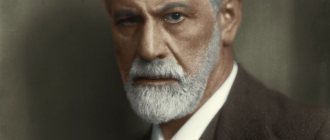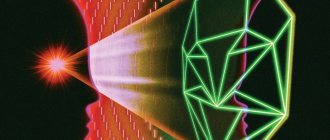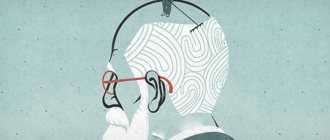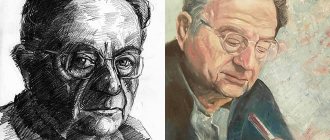According to Freud's theory, the process of personality formation begins at birth and goes through four stages. Each of these stages is associated with a specific area of the body - one or another erogenous zone (mouth, nose, ear, eye, anus, urethra, skin, navel).
On the basis of this idea, academicians V. Ganzen and V. Tolkachev developed vector psychology. This is the doctrine of eight vectors in a person’s character, called “applied system-vector psychoanalysis,” the essence of which boils down to the fact that a person cannot exist alone.
In system-vector psychology, a vector is a set of human qualities that form its system of values, morality, character, and behavioral characteristics. All vectors are innate and do not change throughout life. In this regard, each of these vectors sets a special scenario for a person’s life, and by studying them, you can understand what kind of person this person is and how to behave with him.
There are 8 vectors, that is, 8 types of human “direction”. The vector talks about what exactly a person likes, what kind of self-realization he is instinctively drawn to, what gives him pleasure. To realize his vector in society, a person plays a certain role in it. The name of the vector is identical to the human sensitive zone. So, let's begin:
Basic concepts of psychoanalysis
Here are a few fundamental ideas of psychoanalysis, to one degree or another, inherent in most psychoanalytic methods.
— A person’s behavior, the state of his psyche (consciousness) largely depend on internal unconscious motives, which are determined by LIBIDO or sexual desire (in the process of development, this position was repeatedly corrected or challenged by Freud’s followers).
— The main cause of psychological problems of the individual (neurotic behavior, depression, anxiety, complexes) is the inevitable conflict between unconscious impulses (desires) and the conscious part of the personality.
— A significant weakening of this conflict can be achieved through the individual’s awareness of the traumatic memories that cause the conflict, by releasing this material from the sphere of the unconscious and subsequent work with it through a psychoanalyst (living, analyzing, accepting the traumatic material).
— The human psyche has protective mechanisms that prevent awareness of the contents of the unconscious (main article — Psychological defenses of the individual).
Other theories of Sigmund Freud
All other ideas of Sigmund Freud were built in the field of psychoanalysis. During his work, he talked about human personality and what influences it from the inside and outside. According to one of his theories, a person’s personality can be divided into “I”, “It” and “Super-ego”. According to another, he argued that the energy of a person’s life is contained in his libido, and the energy of death is contained in aggression. The psychoanalytic theory of personality is well covered in the works of Sigmund Freud.
To familiarize yourself with the works of a psychoanalyst, we present several books by Sigmund Freud:
- "Essays on the psychology of sexuality."
- "Me and It."
- "Psychopathology of everyday life."
[Total: 1 Average: 5/5]
The structure of personality (psyche) according to Freud
According to Sigmund Freud's theory, there are three different levels of human consciousness.
1. CONSCIOUSNESS . This is the part of our consciousness that we are aware of at every moment of time. Here our thoughts, ideas, concepts are located, the emotions that accompany the thought process are felt and realized, here, through thoughts and sensations, the rational experience of knowing the world is integrated (perception of information using the senses). Consciousness is the only part of our psyche (and according to Freud, a very insignificant one) that is subject to real awareness and evaluation.
2. PRECONSCIOUS (subconscious). In computer terms, this part of the psyche is a kind of RAM. We are not aware of this part at every moment of time (and it would be irrational), however, if necessary, we always have access to its contents. This contains our memories, our knowledge, in general, this is our memory.
3. UNCONSCIOUS . This is a part of our psyche that is inaccessible to detection and rational awareness. Here is material that, for one reason or another, has been repressed from consciousness and preconsciousness. These are fears, unacceptable aspirations (sexual and aggressive), repressed experiences (most often traumatic), irrational aspirations.
In general, CONSCIOUSNESS, PRECONSCIOUSNESS and the UNCONSCIOUS is a kind of virtual information environment, which, although it is an integral part of our personality, is accessible to it to varying degrees.
The personality itself, which includes all three levels of consciousness (psyche), structurally consists of the following parts - ID (It), Ego (I) and Super Ego (Super Ego) .
— ID (IT) is the original (basic) part of the psyche with which every human being is born, it is an innate, and not acquired as a result of development, part of the personality. It is what is responsible for survival in the real world, responsible for providing our basic needs, through emotional impulses making us WANT to realize these needs.
According to Freud, ID is guided by the principle of maximum pleasure (enjoyment), and by its nature carries the principle of Absolute Egoism and need satisfaction. Metaphorically, for the ID, the only real good is the satisfaction of needs, immediately and at any cost. So an infant, whose personality structure has not yet been formed, is guided by precisely this principle.
In Freudian psychoanalysis, this part of the psyche is believed to reside entirely in the unconscious.
- EGO (I). Freud believed that this part of the personality develops in the first three years of an infant's life. The reason for development is the need to interact with the outside world; the EGO develops, guided by the rational principle of reality. What does this mean? This means that the child begins to understand that immediate and unconditional satisfaction of ID desires is associated with certain difficulties, and their fulfillment must be linked to certain realities of the surrounding world. These realities are the presence of other people, each of whom also has their own desires and needs. Based on experience, there is an awareness that unconditional selfish behavior (what ID requires) can bring certain problems and delay in getting what you want. This is how behavior strategies are gradually formed, taking into account external circumstances. From the point of view of Freud's theory, this part of the psyche is located in consciousness, in the preconscious, and in the unconscious.
- SUPER EGO . According to Freud, this part of consciousness is formed around the age of 5 and contains moral principles (ethics), which are formed in the consciousness due to the influence of parents, other people, as well as the previously described natural external circumstances of the child’s life. It is this part of the personality that is responsible for the formation of assessments of bad - good, acceptable - unacceptable, and subsequently, for the formation of basic ideas about what the world around us is like and what place the person himself occupies in it. Freud divided this part of the personality into two parts - CONSCIENCE and I - IDEAL . SUPER EGO, like EGO, is located in all three “elements”, in consciousness, in preconscious and in the unconscious.
According to Freud, an indicator of a psychologically healthy personality is the effective control of the EGO over the Super Ego and Id. Taking this position, we can conclude that the Ego must be “stronger” than other parts of the personality. In fact, based on the logic of the personality structure, the role of the Ego comes down to rational activity to achieve a compromise between the Id and the Super Ego. However, it should be understood that the role of the Self, in any case, comes down to satisfying the ID as quickly as possible and, at the same time, in the safest possible way for the individual. Finding an ideal compromise between ID and SUPER EGO in real life circumstances in society is almost impossible. Considering this thesis, we can conclude that it is impossible to completely eliminate psychological stress in the human psyche.
If the Super Ego is dominant in a person, then we end up with a Puritan who strictly follows moral principles and (or) high ideas that are at the forefront and the suppressed aspirations of the Id, constantly striving to come out. If the Id is dominant, then this person will constantly strive for pleasure, regardless of other people and social attitudes. The ideal expression of such a situation would be a psychopathic personality with dissocial personality disorder.
Continuation, the next part of the topic is PSYCHOANALYSIS AS A METHOD OF PSYCHOTHERAPY.
Freudian personality theory in brief
Freud structured the human psyche into 3 components: Id, Ego and Superego.
The id is the unconditional source of desires and drives.
By analogy, you can take any animal like a cat, where everything it does: sleeps, eats and mates is the result of its natural instincts. The ego is a mediator between animal instincts and social frameworks. It is a component of the personality that expresses and satisfies the needs of the id in accordance with the constraints of the external world.
The superego is all social frameworks that originate in parental education, where an understanding of what can and cannot be done is given. In adult life, the superego is reflected in all limiting norms of behavior such as law, religion and morality.
The topical model of the mental apparatus consists of 2 components: conscious and unconscious.
The unconscious is special mental forces that lie beyond consciousness and determine the vector of human behavior.
Conscious is the part of the psyche that is conscious of the individual. Determines the choice of behavior in a social environment. However, the psyche is automatically regulated by the pleasure principle. When the balance is disturbed, a reset occurs through the unconscious sphere.
The conflict between the Id and the Superego is realized through defense mechanisms. Sigmund Freud described some of them:
- Substitution
- Compensation
- crowding out
- Insulation
- Negation
- Projection
- Sublimation
- Rationalization
- Regression
Let us briefly examine the most interesting defense mechanisms to better understand what they are.
Defense mechanisms of the psyche
Projection is a way of transferring one's own feelings and secret desires to another animate or inanimate object. For example, a prude is a person who hides true sexual desires and looks for the slightest dirty intentions in the actions of others.
As for inanimate things, these are examples of situations in which a person endows objects or phenomena with his experiences. For example, a menacing sky, a disturbing sculpture, harmful alcohol, etc.
By the way, there are diagnostic techniques based on projections. For example, a hand test, in which the participant is shown drawings of a hand, and he gives his associations and feelings from what he saw.
Repression is the suppression and removal from the conscious part of the psyche of unacceptable and personality-threatening thoughts, images and memories. An example would be a strong shock such as the death of a person, a disaster, or a change in one’s zodiac sign.
A person often does not remember the details and key moments of a given event. Despite the fact that the content of the repressed motive is not realized, the emotional component continues to manifest itself in different forms.
Having defined the fundamental foundations on which Freud's theory is built, we can consider in more detail the concept of psychoanalysis as a branch of the science of psychology.
The techniques used by psychoanalysis are free association, dream interpretation, interpretation, resistance and transference analysis. All of them are aimed at working with the unconscious and bringing unconscious processes into the conscious area.
When this happens, the negative symptoms disappear.
For example, during attacks of fear and uncontrollable anxiety, a person is not aware of their cause and tries to find a rational explanation. In this example, along with repression, such a protective mechanism of the psyche as rationalization works. To identify and define unconscious processes in the brain, Freud asked patients to talk about free topics. As a rule, repressed processes manifest themselves in the form of neurotic symptoms: slips of the tongue, misspellings and awkward movements.











